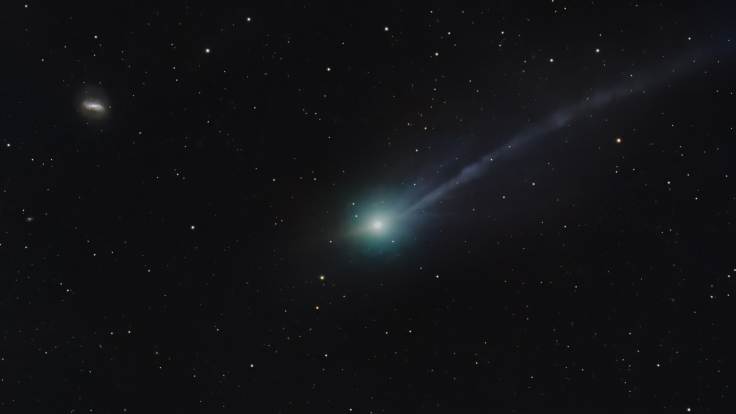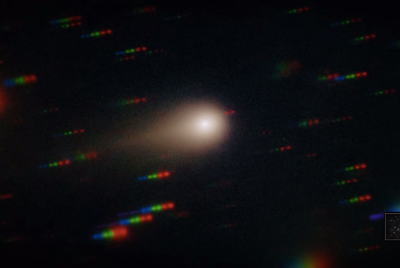3I/ATLAS Reveals Unusual Tail Structure in New Mexico Photo, Igniting Debate
Observers suggest its behaviour defies standard cometary physics

An extraordinary image captured in New Mexico by the 3I/ATLAS project has unveiled a celestial object with a highly unusual tail structure.
This remarkable photographic evidence has immediately sparked a spirited debate among astronomers and space enthusiasts alike, challenging the conventional understanding of comet and asteroid formations.
A remarkable new photograph of the interstellar object 3I/ATLAS, taken on 16 November in New Mexico, has generated excitement and speculation among astronomers and skywatchers.
The image, widely shared online, clearly shows a distinctly sharp, drawn-out tail structure and unusual, twisting streams of material. Several observers suggest that these features do not match the typical behaviour of a comet.
Stunning New Mexico Capture
The photograph, which was taken between 11:53:50 and 12:23:20 UTC, circulated via the ICQ Comet Observations network. It was then shared on X by users Astronomy Vibes (@AstronomyVibes) and Space Initiatives (@AsteroidEnergy).
Summarising the findings, Asteroid Energy stated, 'It looks like our interstellar visitor 3I/ATLAS has finally gotten a dust tail. Very nice picture from ICQ Comet Observations'.
It looks like our interstellar visitor 3I/ATLAS has finally gotten a dust tail. Very nice picture from
— Space Initiatives (@AsteroidEnergy) November 16, 2025
ICQ Comet Observations
Satoru Murata
2025-11-16 11:53:50~12:23:20 UTC
New Mexico, USA pic.twitter.com/tV29lTMDsi
3I/ATLAS — the third interstellar body discovered passing through our solar system — has faced intense observation since scientists first found it. However, this latest picture shows the object in its most striking form to date.
READ MORE: 3I/ATLAS Survived Perihelion as Single Body — Harvard's Loeb Questions Its Origin
READ MORE: 3I/ATLAS: Harvard's Loeb Urges NASA To Release 40-Day-Old HiRISE Images Amid Global Intrigue
The Post That Generated Excitement
The post, which garnered wide attention from Astronomy Vibes, presented the photo alongside a bold inquiry, 'Alien Visitor or Cosmic Trick? The New 3I/ATLAS Image Will Shock You'. The description accompanying the post offered a clear depiction of what watchers are noticing.
'At first glance, a bright green coma pulses softly, like the heartbeat of a lonely traveler drifting across the stars. But then... your eyes are drawn to the tail — impossibly long, sharp, slicing through the darkness like a blade carved by the cosmos itself.'
🚨 Alien Visitor or Cosmic Trick? The New 3I/ATLAS Image Will Shock You 🚨
— Astronomy Vibes (@AstronomyVibes) November 17, 2025
A jaw-dropping new image of 3I/ATLAS has just surfaced — captured in New Mexico on November 16 — and astronomers are buzzing. This interstellar traveler isn’t just glowing… it’s putting on a show.
At… pic.twitter.com/CamlGsnOTk
The picture also seems to uncover slight streams coming from the object's centre — 'tiny twisting jets spiral from its core, as if this interstellar wanderer is alive, whispering secrets we can't yet understand'.
This vivid phrasing has certainly helped capture public interest, but both professional and hobbyist astronomers acknowledge that the structural characteristics visible in the picture are truly unique. 'Interstellar object 3I/ATLAS continues to defy expectations', wrote NMSI - Oscillating Physics in the comments section, offering further insight on the body in their reply.
Interstellar object 3I/ATLAS continues to defy expectations.
— NMSI - Oscillating Physics (@PCosmologist) November 17, 2025
This latest image, captured on November 16 in New Mexico, reveals a coma that appears unusually well-structured, both in brightness and uniformity. The tail sharp, narrow, and remarkably straight extends far beyond…
'Whether 3I/ATLAS is a natural visitor behaving in extreme conditions or something that challenges our current framework, this much is clear, its behavior is coherent, persistent, and increasingly hard to fit inside standard cometary physics', NMSI - Oscillating Physics added, concluding the response with, 'The deeper we look, the more the object seems intent on rewriting the rules'.
READ MORE: Harvard's Avi Loeb Claims 3I/ATLAS Could Be 'Artificial' If No Gas Cloud Seen
READ MORE: 3I/ATLAS Survived Perihelion as Single Body — Harvard's Loeb Questions Its Origin
Experts Offer Views: Genuine, Not an Editing Error
While social media frequently encourages overstatement, the X post emphasises that the picture is authentic, asserting that observers have verified it is 'no trick, no glitch, no edit. This is real — and coming from a world that didn't even originate in our solar system'.
This claim aligns with the findings of astronomers to date. Boosting the contrast in astrophotography often reveals features that are not visible naturally, yet the distinct tail and the likely existence of streams appear uniform throughout several photographs. This indicates these qualities are inherent to the object.
Deciphering the Tail: Rock, Frozen Material, or Unknown?
Although 3I/ATLAS had a coma recorded previously, this image represents the initial occasion on which a clear dust tail has been plainly visible. Interstellar bodies are famously unreliable; in contrast to comets orbiting our Sun, their activity levels do not consistently follow expected routines.
The dust tail — extended, slender, and notably clear — has prompted people to compare it with both highly active comets and unusual entities such as ʻOumuamua, which demonstrated movement not caused by gravity despite lacking a visible tail. Yet, in this situation, the tail is impossible to miss.
🚨 BREAKING NEWS 🚨
— E-BANGER 🛸 (@Dapeaq) November 7, 2025
New images reveal something deeply unsettling about interstellar object 3I/ATLAS — it still has no visible tail. There’s nothing so far, no debris, no dust, no plume.#UFOx #uap #uapx #ufotwitter #disclosure #3IATLAS pic.twitter.com/50Z4G2E2Np
Asteroid Energy's X post merely observed that the body has 'finally gotten a dust tail'. Still, researchers are currently discussing the processes that might create such a fine, knife-like characteristic.
An Exceptional Look at a Cosmic Intruder
Astronomy Vibes referred to 3I/ATLAS as 'a true outsider... leaving clues we've never seen before'. This description highlights a sincere feeling of inquisitiveness throughout the astronomy world. Guests from outside our system provide a brief chance to examine matter created near far-off stars, and every one contains distinctive markers of where it came from.
The twisting jets suggested in the image, if confirmed, might point towards rapid rotation or uneven gas release — actions that could help scientists understand how 3I/ATLAS developed and the duration it has been moving through interstellar space.
The Puzzle Grows More Complex
Astronomy Vibes finished its post with several inquiries that appear to reflect the wider awe felt by the community. 'What secrets does 3I/ATLAS hide inside its glowing core? And why does it feel... almost deliberate?'
While the phrasing is dramatic, the underlying sentiment is genuine. Each new observation yields more questions than definitive answers. Because the object is already passing swiftly through the inner solar system, scientists understand their opportunity to observe it will shortly end.
For now, the New Mexico picture serves as one of the most distinct — and yet confounding — views of an interstellar body in motion, offering an unusual glimpse of a visitor from outside our cosmic region.
© Copyright IBTimes 2025. All rights reserved.




















